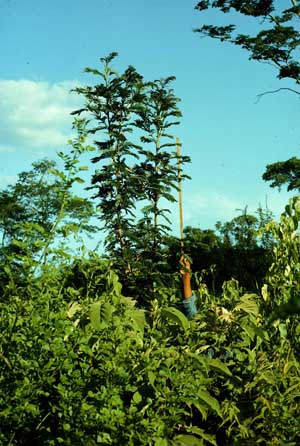|
|
 57 shade and ant-acacias DHJanzen100139.jpg high resolution
|
|
| The impact of removal of the acacia-ants is not expressed merely by increased herbivory. The ant-acacia lives in secondary (and primary) succession that is rich in fast-growing other plants, all of which are racing upward. The ant-acacia clearly belongs to the group of plants that is sun-loving and does very poorly in shade (as is commonplace with plant lineages with desert or arid-land origins, which is the case with Acacia specifically and mimosoid legumes in general). When it begins to suffer herbivore damage, it also, then, begins to put on vertical height less rapidly, and when overtopped by the adjacent foliage of other species, declines in health and vigor extremely rapidly just from shading. So, the same experiment as described above was duplicated, but ONLY the ant-acacias were cut down. The results were dramatic. A year later the occupied ant-acacia sucker shoots had been able to nearly regain their original height (see the ant-acacia in the photo), and in some cases had done even better because their original more bush-like form (created by early months of growth with a weak ant colony) was left behind (cut off) and all resources (and the large ant colony) poured into 1-2 major central shoots. See following photograph for the consequences of no ant colony plus shade. | ||
back to lecture slides
or skip to: